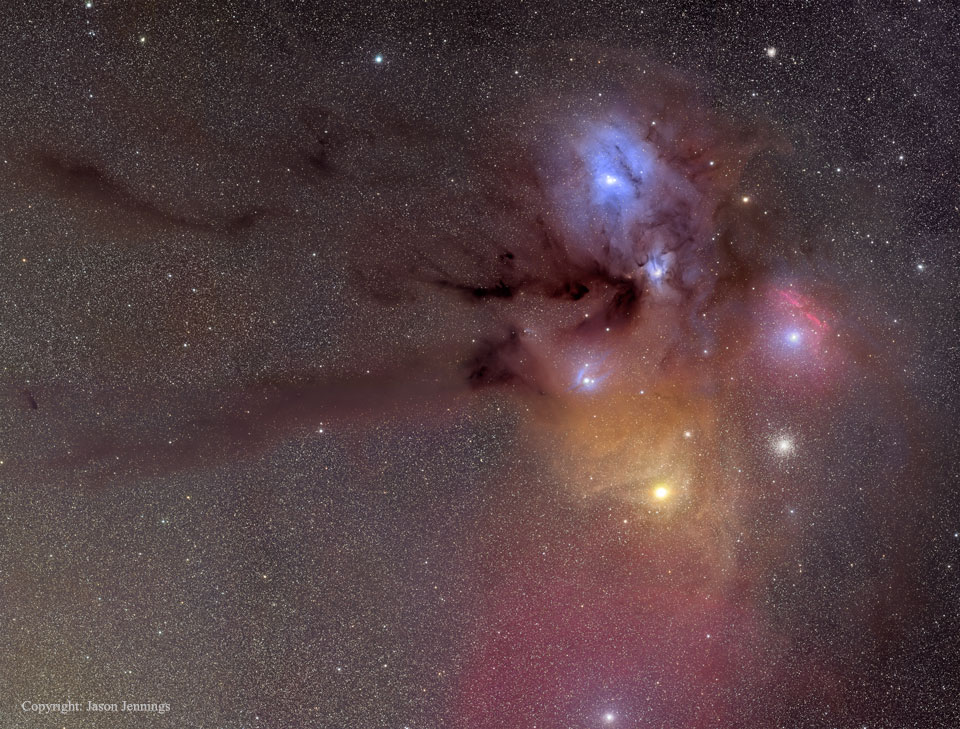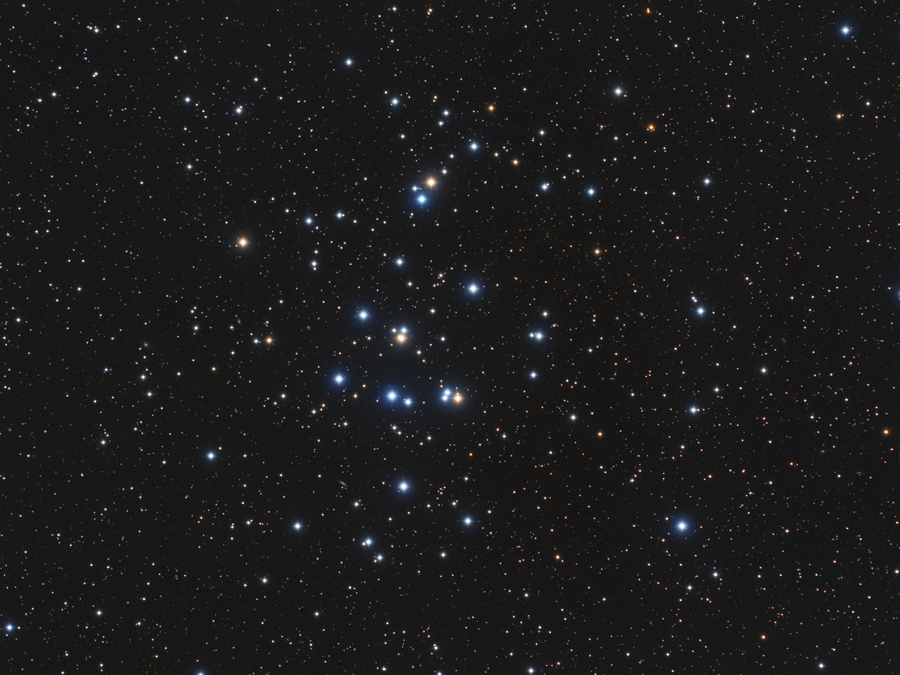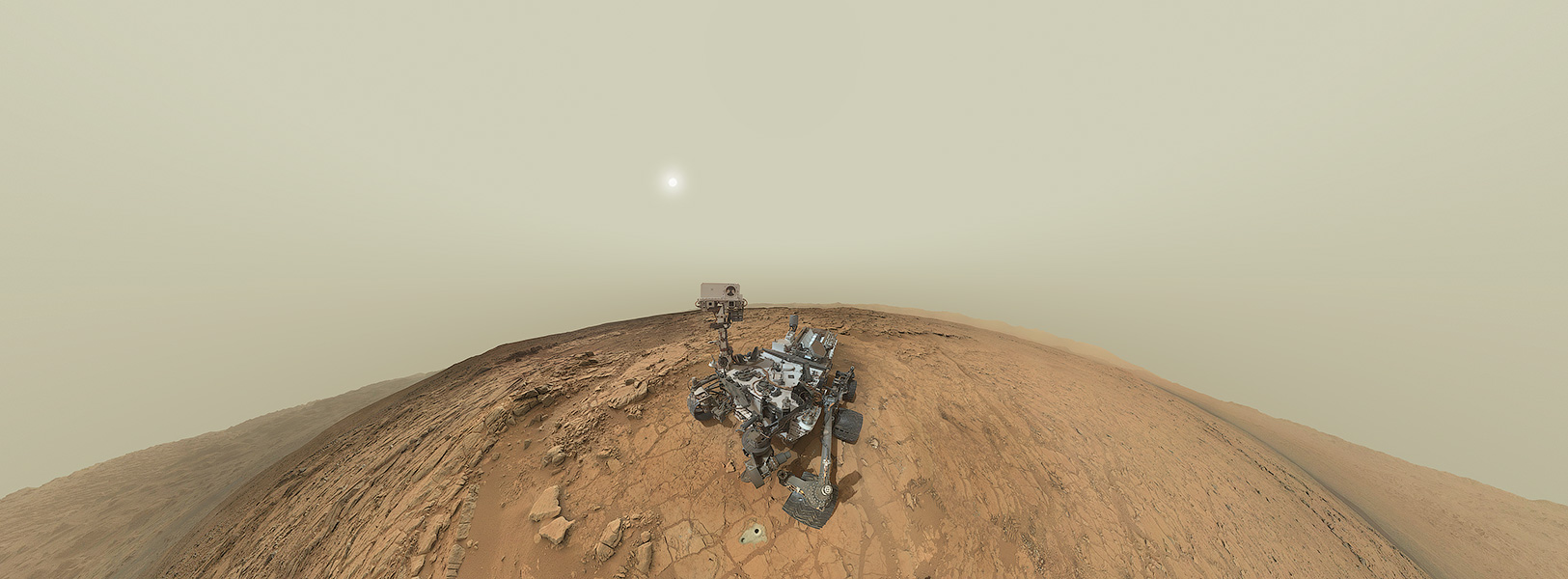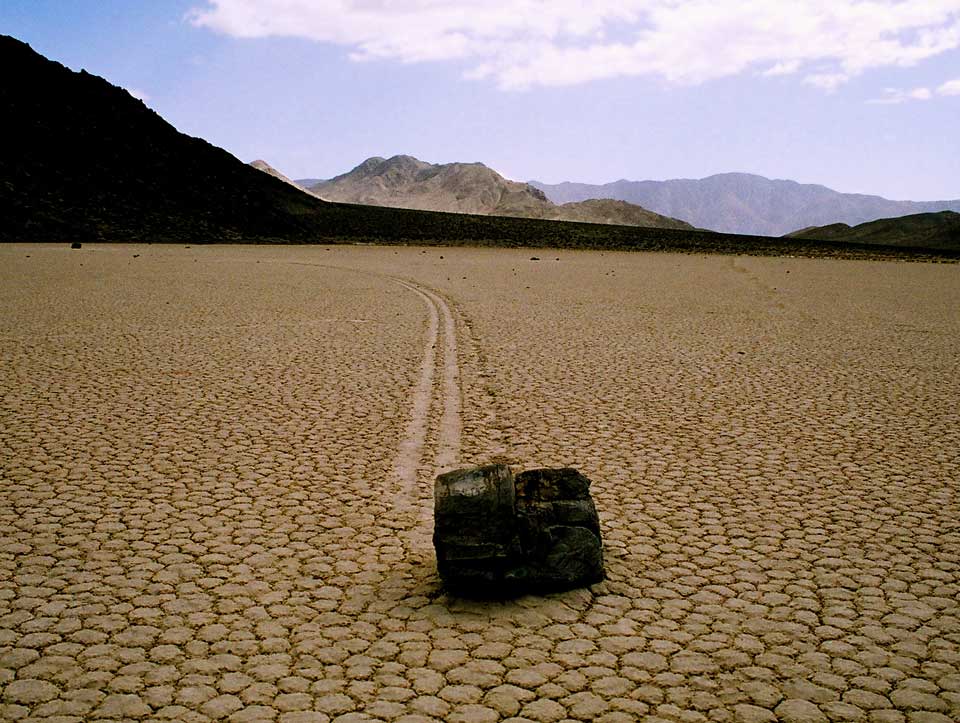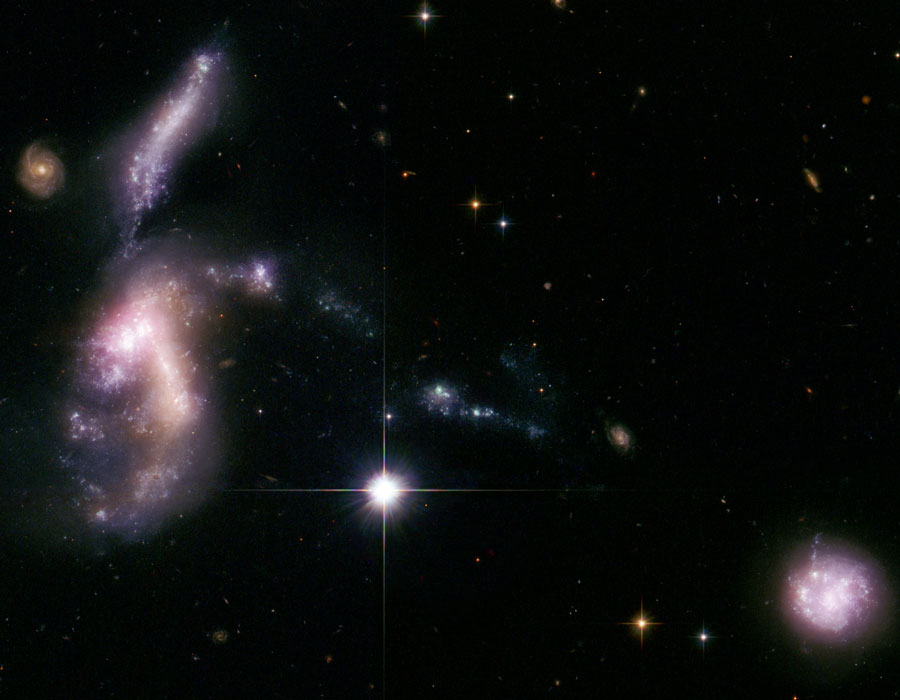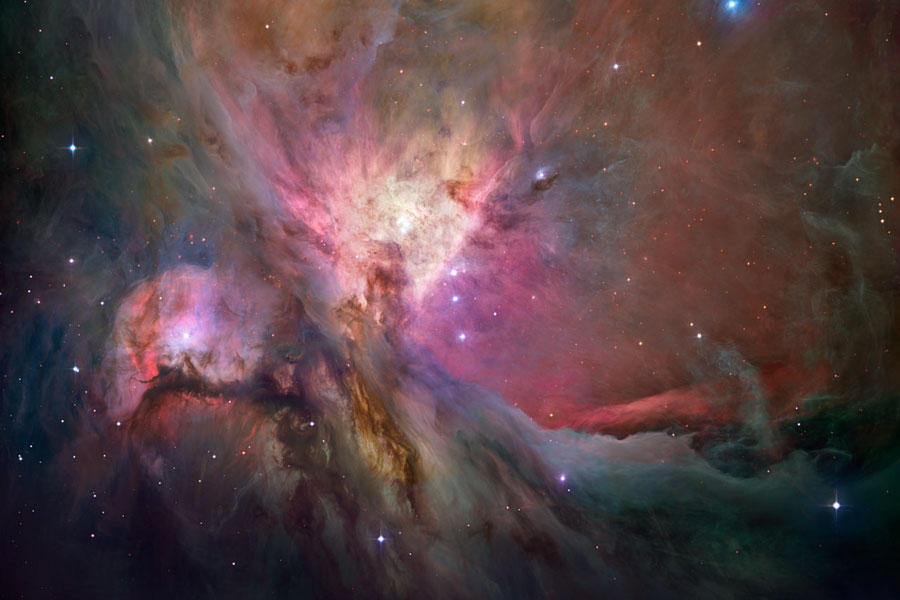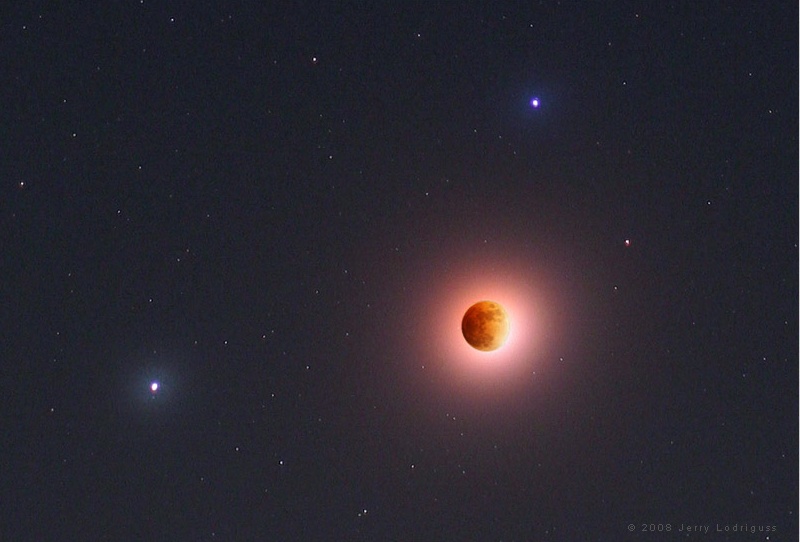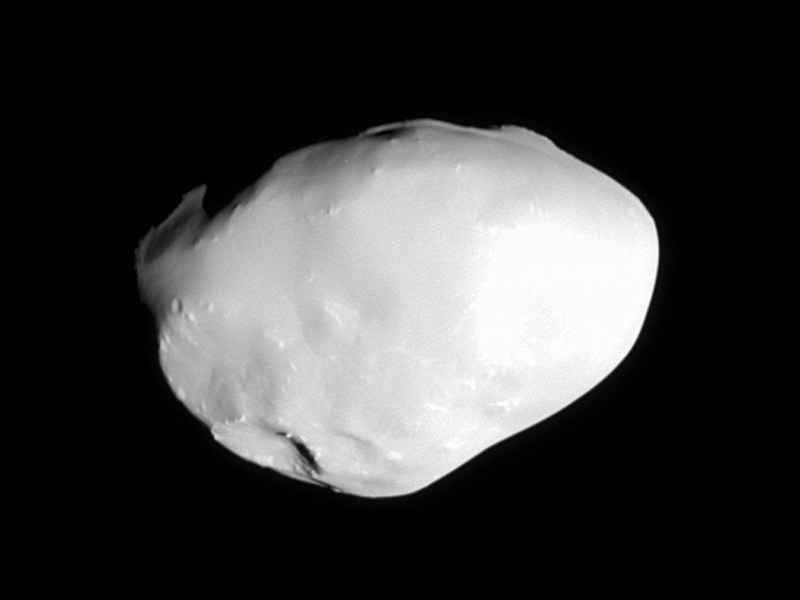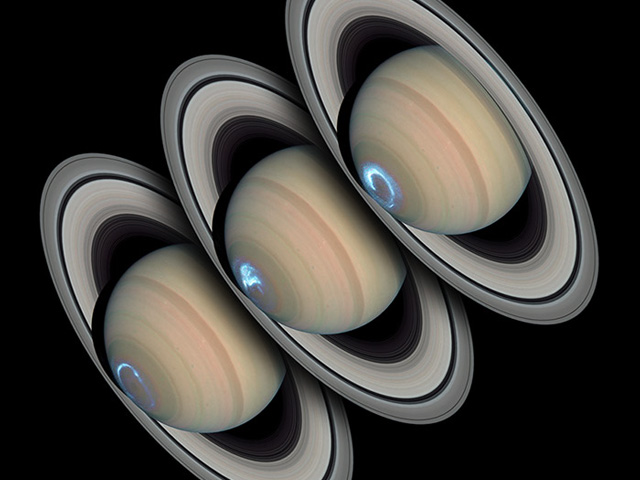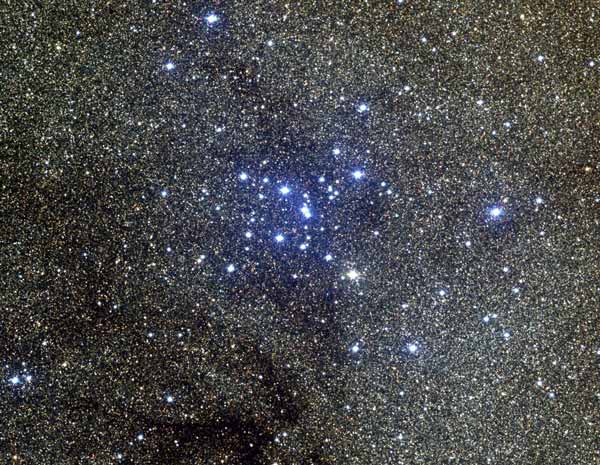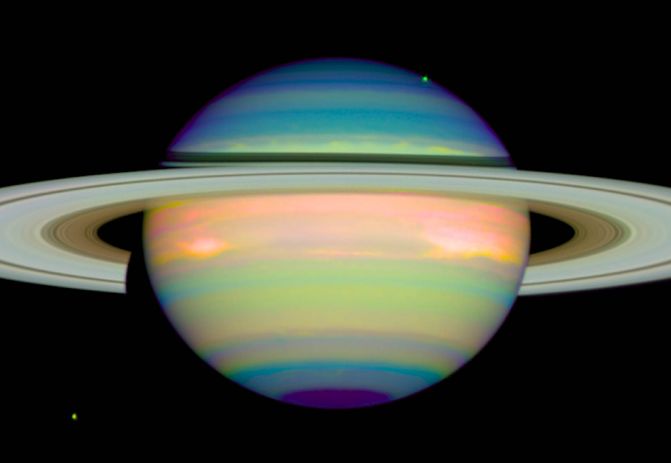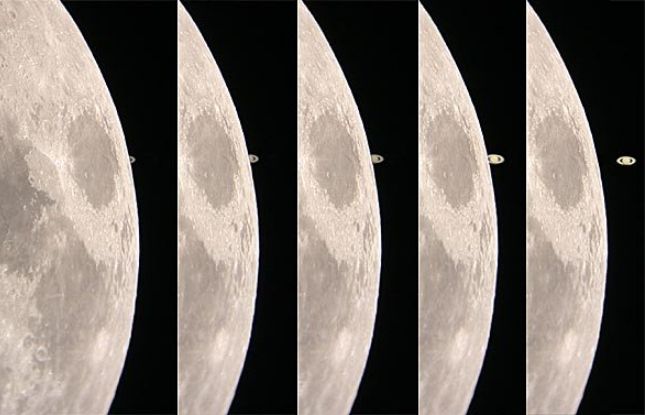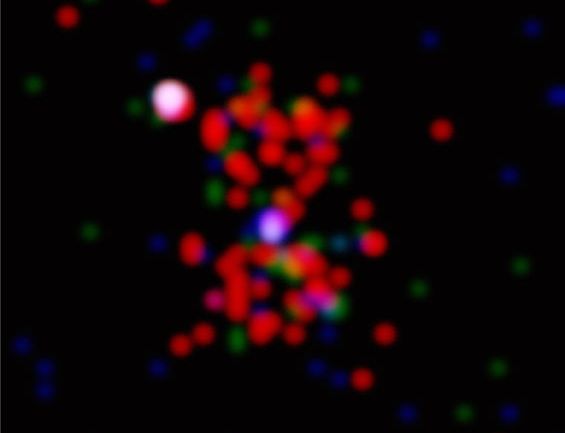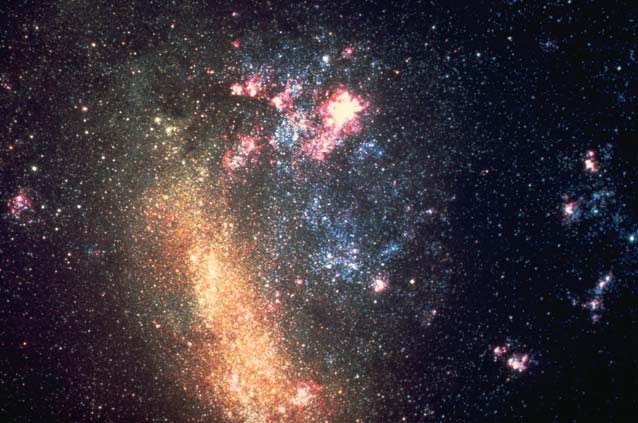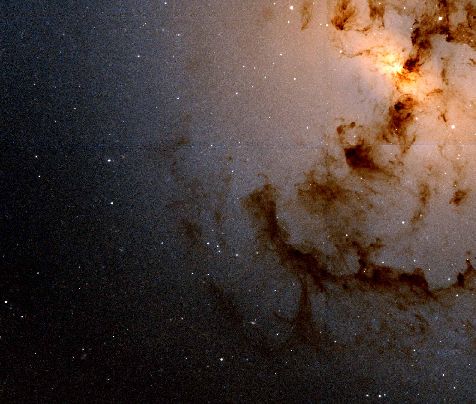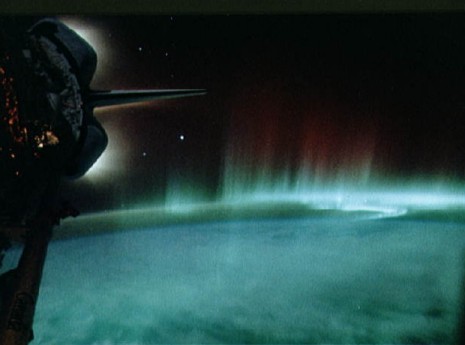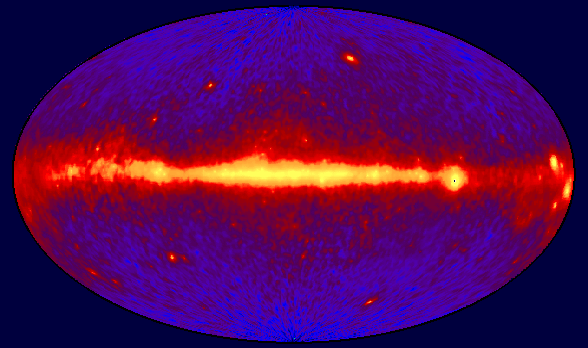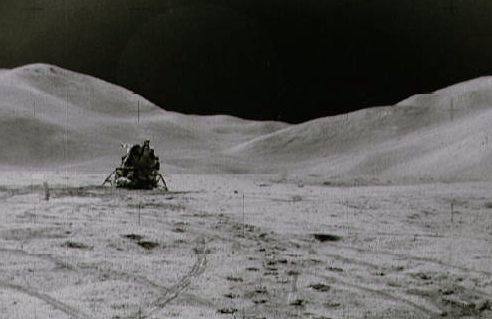| << Previous | Index | Next >> |
2015Connecting the Pipe Nebula to the colorful region near bright star Antares is a dark cloud dubbed the Dark River, flowing from the picture's left edge. Murky looking, the Dark River's appearance is caused by dust obscuring background starlight, although the dark nebula contains mostly hydrogen and molecular gas. Surrounded by dust, Antares, a red supergiant star, creates an unusual bright yellowish reflection nebula. Above it, bright blue double star Rho Ophiuchi is embedded in one of the more typical bluish reflection nebulae, while red emission nebulae are also scattered around the region. Globular star cluster M4 is just seen above and right of Antares, though it lies far behind the colorful clouds, at a distance of some 7,000 light-years. The Dark River itself is about 500 light years away. The colorful skyscape is a mosaic of telescopic images spanning nearly 10 degrees (20 Full Moons) across the sky in the constellation of the Scorpion (Scorpius).
2014 A mere 600 light-years away, M44 is one of the closest star clusters to our solar system. Also known as the Praesepe or the Beehive cluster its stars are young though, about 600 million years old compared to our Sun's 4.5 billion years. Based on similar ages and motion through space, M44 and the even closer Hyades star cluster in Taurus are thought to have been born together in the same large molecular cloud. An open cluster spanning some 15 light-years, M44 holds 1,000 stars or so and covers about 3 full moons (1.5 degrees) on the sky in the constellation Cancer. Visible to the unaided eye, M44 has been recognized since antiquity. Described as a faint cloud or celestial mist long before being included as the 44th entry in Charles Messier's 18th century catalog, the cluster was not resolved into its individual stars until telescopes were available. A popular target for modern, binocular-equiped sky gazers, the cluster's few yellowish tinted, cool, red giants are scattered through the field of its brighter hot blue main sequence stars in this colorful stellar group snapshot.
2013 This remarkable self-portrait of NASA's Mars Curiosity Rover includes a sweeping panoramic view of its current location in the Yellowknife Bay region of the Red Planet's Gale Crater. The rover's flat, rocky perch, known as "John Klein", served as the site for Curiosity's first rock drilling activity. At the foot of the proud looking rover, a shallow drill test hole and a sample collection hole are 1.6 centimeters in diameter. The impressive mosaic was constructed using frames from the rover's Mars Hand Lens Imager (MAHLI) and Mastcam. Used to take in the panoramic landscape frames, the Mastcam is standing high above the rover's deck. But MAHLI, intended for close-up work, is mounted at the end of the rover's robotic arm. The MAHLI frames used to create Curiosity's self-portrait exclude sections that show the arm itself and so MAHLI and the robotic arm are not seen. Check out this spectacular interactive version of Curiosity's self-portrait panorama.
2012 How did this big rock end up on this strange terrain? One of the more unusual places here on Earth occurs inside Death Valley, California, USA. There a dried lakebed named Racetrack Playa exists that is almost perfectly flat, with the odd exception of some very large stones, one of which is pictured above. Now the flatness and texture of large playa like Racetrack are fascinating but not scientifically puzzling -- they are caused by mud flowing, drying, and cracking after a heavy rain. Only recently, however, has a viable scientific hypothesis been given to explain how 300-kilogram sailing stones ended up near the middle of such a large flat surface. Unfortunately, as frequently happens in science, a seemingly surreal problem ends up having a relatively mundane solution. It turns out that high winds after a rain can push even heavy rocks across a temporarily slick lakebed.
2011
Click to play embedded YouTube video.
Credit & Copyright: morn1415 (YouTube)
2010
2009 Few cosmic vistas excite the imagination like the Orion Nebula. Also known as M42, the nebula's glowing gas surrounds hot young stars at the edge of an immense interstellar molecular cloud only 1,500 light-years away. The Orion Nebula offers one of the best opportunities to study how stars are born partly because it is the nearest large star-forming region, but also because the nebula's energetic stars have blown away obscuring gas and dust clouds that would otherwise block our view - providing an intimate look at a range of ongoing stages of starbirth and evolution. This detailed image of the Orion Nebula is the sharpest ever, constructed using data from the Hubble Space Telescope's Advanced Camera for Surveys and the European Southern Observatory's La Silla 2.2 meter telescope. The mosaic contains a billion pixels at full resolution and reveals about 3,000 stars.
2008 Moon watchers blessed with clear skies over the Americas, Europe, Africa and western Asia enjoyed a total lunar eclipse this week. Catching eclipsed moonlight, astroimager Jerry Lodriguss offers this view of the inspiring celestial event with the shadowed Moon accompanied by wandering planet Saturn at the left, and bright Regulus, alpha star of the constellation Leo, above. The engaging composite picture was made by combining a filtered, telephoto image of the Moon and surrounding starfield with a telescopic exposure. The combination dramatizes the reddened moonlight while clearly showing the variation of brightness and color in Earth's not-so-dark shadow across the lunar surface.
2007
[imghover6=http://apod.nasa.gov/apod/image/0702/So ... omenon.jpg]http://apod.nasa.gov/apod/image/0702/So ... _label.jpg[/imghover6]Credit & Copyright: Ray Palmer
2006 Why is Saturn's small moon Telesto so smooth? Possibly Telesto is covered with a type of granular icy material similar to that suspected of covering Pandora, another of Saturn's small moons. If so, Telesto might be more like a pile of rubble than a solid body. This recently uncovered Solar System mystery is currently a topic of research, however. The unexpected finding originated last October when the robot Cassini spacecraft, currently orbiting Saturn, swooped past the 24-kilometer moon and captured the first ever image of Telesto's surface. Telesto orbits Saturn always just ahead of the much larger moon Tethys. Pictured above, Telesto's unusually smooth surface was found to show some large craters and boulders, but not the high density of craters found on nearby Tethys or most other Saturnian moons.
2005 Are Saturn's auroras like Earth's? To help answer this question, the Hubble Space Telescope and the Cassini spacecraft monitored Saturn's South Pole simultaneously as Cassini closed in on the gas giant in January 2004. Hubble snapped images in ultraviolet light, while Cassini recorded radio emissions and monitored the solar wind. Like on Earth, Saturn's auroras make total or partial rings around magnetic poles. Unlike on Earth, however, Saturn's auroras persist for days, as opposed to only minutes on Earth. Although surely created by charged particles entering the atmosphere, Saturn's auroras also appear to be more closely modulated by the solar wind than either Earth's or Jupiter's auroras. The above sequence shows three Hubble images of Saturn each taken two days apart.
2004 M7 is one of the most prominent open clusters of stars on the sky. The cluster, dominated by bright blue stars, can be seen with the naked eye in a dark sky in the tail of the constellation of Scorpius. M7 contains about 100 stars in total, is about 200 million years old, spans 25 light-years across, and lies about 1000 light-years away. This color picture was taken in 1995 at the Burrell-Schmidt Telescope at Kitt Peak National Observatory in Arizona. The M7 star cluster has been known since ancient times, being noted by Ptolemy in the year 130 AD. Also visible is a dark dust cloud near the bottom of the frame, and literally millions of unrelated stars towards the Galactic center.
2003 This delightfully detailed false-color image of Saturn was taken in January 1998 by the orbiting Hubble Space Telescope. The picture is a combination of three images from Hubble's NICMOS instrument and shows the lovely ringed planet in reflected infrared sunlight. Different colors indicated varying heights and compositions of cloud layers generally thought to consist of ammonia ice crystals. The eye-catching rings cast a shadow on Saturn's upper hemisphere. The bright stripe seen within the left portion of the shadow is infrared sunlight streaming through the large gap in the rings known as the Cassini Division. Two of Saturn's many moons have also put in an appearance, Tethys just beyond the planet's disk at the upper right, and Dione at the lower left. Presently, Saturn shines brightly in evening skies as a pale yellow "star" near the constellation Orion.
2002 Gliding through the sky on Wednesday evening, February 20th, a first quarter Moon seemed to run over bright planet Saturn as viewed from much of North America. In this sharp sequence of telescopic digital images from the Powell Observatory near Louisburg, Kansas, USA, Saturn is seen reappearing from behind the bright lunar limb over a period of about 2 minutes. The ringed planet emerges above the dark, smooth lunar Mare Crisium (Sea of Crises). This lunar occultation was widely anticipated in part because the ringed planet and the brilliant Moon are both spectacular celestial sights. Now, European sky gazers will have their turn as the Moon occults the Solar System's largest planet, Jupiter in early morning hours on Saturday, February 23rd.
2001 Large clusters of galaxies are the most massive objects in the universe. Astronomers now realize that a hallmark of these cosmic behemoths are gas clouds with temperatures of tens of millions of degrees that pervade the clusters and radiate strongly in x-rays. This Chandra Observatory image centered on a radio galaxy cataloged as 3C294 indeed reveals the telltale hot x-ray gas in an hourglass shaped region surrounding the dominant galaxy and shows the presence of a massive galaxy cluster in the distant universe. Here the picture is color-coded by x-ray energy, red for low, green for medium, and blue for high energy x-rays. The cluster associated with 3C294 is 10 billion light-years away making it the most distant x-ray galaxy cluster ever detected. Objects at that extreme distance existed when the universe was young, a mere 20 percent of its present age. Impressively, this observation demonstrates that even at those early times massive clusters of galaxies were already present.
2000 The brightest galaxy visible from our own Milky Way Galaxy is the Large Magellanic Cloud (LMC). Visible predominantly from Earth's Southern Hemisphere, the LMC is the second closest galaxy, neighbor to the Small Magellanic Cloud, and one of eleven known dwarf galaxies that orbit our Milky Way Galaxy. The LMC is an irregular galaxy composed of a bar of older red stars, clouds of younger blue stars, and a bright red star forming region visible near the top of the above image called the Tarantula Nebula. The brightest supernova of modern times, SN1987A, occurred in the LMC.
1999 Astronomers turn detectives when trying to figure out the cause of unusual sites like NGC 1316. A preliminary inspection indicates that NGC 1316 is an enormous elliptical galaxy that started devouring a smaller spiral galaxy neighbor about 100 million years ago. Supporting evidence includes the dark dust lanes uniquely indicative of a spiral. What remains unexplained are the unusually small globular star clusters, visible as faint dots on the above photograph. Most elliptical galaxies have more and brighter globular clusters than evident in NGC 1316. Yet the observed globulars are too old to have been created by the recent spiral collision. One hypothesis therefore holds that these globulars survive from an even earlier galaxy that was subsumed into NGC 1316.
1998 A background of distant stars, sinuous and spiky bands of Southern Lights (Aurora Australis), and the faint glow of charged plasma (ionized atomic gas) surrounding the Space Shuttle Discovery's engines give this photo from the STS-39 mission an eerie, otherworldly look. This image reflects Discovery's April 1991 mission well - its payload bay (PLB) was filled with instruments designed to study celestial objects, aurora and atmospheric phenomena, and the low Earth orbit environment around the PLB itself. The aurora seen here are at a height of about 50-80 miles. Aurora are caused by charged particles in the solar wind, channeled through the Earth's magnetic field which excite molecules in the upper atmosphere.
1997 What if you could "see" gamma rays? If you could, the sky would seem to be filled with a shimmering high-energy glow from the most exotic and mysterious objects in the Universe. In the early 1990s NASA's orbiting Compton Observatory, produced this premier vista of the entire sky in gamma rays - photons with more than 40 million times the energy of visible light. The diffuse gamma-ray glow from the plane of our Milky Way Galaxy runs horizontally through the false color image. The brightest spots in the galactic plane (left of center) are pulsars - spinning magnetized neutron stars formed in the violent crucibles of stellar explosions. Above and below the plane, quasars, believed to be powered by supermassive black holes, produce gamma-ray beacons at the edges of the universe. The nature of many of the fainter sources remains unknown.
1996 The lunar module shown above, named "Falcon," served as home for Apollo 15 astronauts David Scott and James Irwin during their stay on the Moon in July and August 1971. Meanwhile, astronaut Alfred Worden circled in the command module overhead. Harsh sunlight on the grey lunar surface lends the image an eerie quality, while the Lunar Apennine Mountains frame the background with Mount Hadley Delta visible on the right. Visible in the foreground are tracks from the first Lunar Roving Vehicle, an electric car which enabled the astronauts to explore extended areas on the lunar surface. Apollo 15 confirmed that most lunar surface features were created by impacts. Rocks returned by the Apollo 15 crew included green glasses whose formation mechanism is still unclear.
| << Previous | Index | Next >> |
